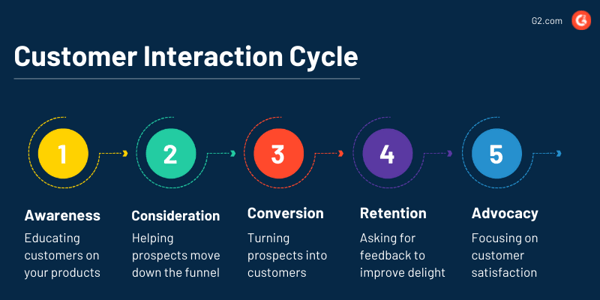July 9, 2025
.jpg?width=400&height=150&name=G2Headshots_Aayushi_Sanghavi_ZOE1415-Edit%20(1).jpg) by Aayushi Sanghavi / July 9, 2025
by Aayushi Sanghavi / July 9, 2025

Today’s customers expect answers in seconds, not hours, and they expect those answers to be clear, helpful, and personal. Whether it’s a quick reply on social media or a deep-dive product discussion over email, every interaction shapes how customers perceive your brand.
But here’s the catch: managing those conversations across chatbots, support tickets, phone calls, and social media can get messy — fast. Without a clear strategy, businesses risk missed messages, inconsistent service, and lost opportunities to build trust.
That’s where customer communications management software comes in. By centralizing conversations and analyzing interaction data, CCM tools help teams respond faster, personalize smarter, and turn every exchange into a better customer experience.
Customer interaction refers to the direct communication between a business and its customers through channels such as phone calls, emails, social media, live chat, and in-person meetings. These interactions aim to resolve issues, answer questions, build relationships, and improve customer satisfaction and loyalty.
Effective customer conversations help meet customer expectations while building trust and loyalty toward your brand and products. While there are several ways to improve your customer interaction practices, it’s important to remember that communication is an ongoing process and requires consistent time and effort.
Customer interactions play an integral role in every step of the customer journey – from the first impression during customer onboarding to requesting feedback and maintaining customer loyalty.
The customer interaction cycle is simply the process of moving a single customer down the sales funnel based on their interactions with a business. It’s a strategic approach to further understand customer interaction management and how several conversations can be stored and used for a better customer experience.
Successful businesses have a strong understanding of the different stages in the customer interaction process. Here are the five main steps to consider when helping a customer make a buying decision.

Pro Insight: Managing customer interactions across these stages prevents churn and turns one-time buyers into repeat fans.
Imagine if every difference with your friend could potentially end your friendship; very unfortunate, right?
That’s precisely how customer interactions work, except that your business could suffer big-time if conversations go wrong. Below are the reasons why customer interaction is critical to your business.
Powerful customer interaction management is the foundation of any successful business. When you interact with a customer, you enable them to voice their concerns, provide feedback, and give insights on what you can do to improve their experience.
Positive customer interactions help analyze what is and isn’t working well for your primary stakeholders. This leads to understanding their pain points and purchasing habits, giving you real-time data on what can be done better.
No one likes losing customers. When customers feel heard and believe you care, they’re more likely to speak their minds about their experiences. This helps businesses re-evaluate their customer satisfaction activities and review the existing strategies. Honest and transparent customer communication paves the way for low customer attrition rates and improves retention.
Customer communication management is a great way to get insights into your customers’ likes and dislikes. Every interaction offers a different perspective and is a learning opportunity to optimize your product and customer service.
When a business pays attention to the customer’s voice, it indirectly improves its current operations through regular feedback.
Putting effort into creating a positive customer interaction also reduces the chances of negative word-of-mouth reviews. This improves your brand image and enhances the probability of getting referrals from existing customers.
Recommendations help grow the customer base organically and are impactful in acquiring new customers. It’s simple: If someone likes your product, they’ll recommend someone else try it. Easy wins.
Reputation management can take years to get right. But managing interactions can make it easier to turn new and existing customers into advocates for your brand. This can be achieved by consistently providing a positive customer experience and responding to grievances across channels.
Loyal customers are often the ones who drive a business forward and repeatedly buy from you. Establishing strong relationships with customers who believe in your vision has a substantial impact on your bottom line.
Effective customer service interactions can also help win back lost customers, showing that you care about them and want to maintain a good customer relationship.
To manage customer interactions consistently, teams need a repeatable framework. Enter L.U.R.O.I.:
| Step | What it means | Example in action |
| Listen | Actively pay attention to what the customer says (and feels). | Sentiment tracking on support tickets. |
| Understand | Clarify needs and context behind the request. | Reviewing the client’s past interactions. |
| Respond | Provide a clear, empathetic answer. | Live chat walk-through of a confusing feature. |
| Optimize | Log insights and improve processes over time. | Updating onboarding content based on common questions. |
| Iterate | Refine the approach based on performance data. | Monthly CSAT reviews and training updates. |
This customer interaction model helps teams stay empathetic, clear, and continuously improve.
Great conversations build great businesses. Whether you're sending onboarding emails, managing customer support chats, or delivering important service updates, the right customer communications management (CCM) software keeps your messaging clear, consistent, and scalable.
On G2, explore verified reviews from real users and find tools that help your team create meaningful, multi-channel conversations, without the chaos.
Not every customer reaches out for the same reason or in the same mindset. Some are excited, some are curious, and some are frustrated. Recognizing the different types of customer interactions helps teams personalize responses, solve problems faster, and strengthen relationships.
Here’s a breakdown of key customer communication types, what they mean for your business, and how to manage them effectively.
Customer onboarding is one of the most crucial customer service interactions. It brings in new customers unaware of the product and teaches them how to use it. These interactions require regular review and feedback mechanisms to adapt to different types of customers.
New relationships offer great potential to reduce churn and negative reviews early on. Free trials and demos are also a good way to increase product awareness and improve first-time interactions.
Why it matters: Great onboarding reduces early churn and increases product adoption rates.
Example Metrics:
This customer is likely in the awareness or consideration stages of their buying journey, reaching out to customer service representatives for answers.
Your customer service and sales teams need to work together to educate such prospects using top-of-the-funnel content (TOFU) content. Direct users to product blogs, how-to guides, and checklists to provide more resources.
This type of customer interaction focuses on the product and customer needs and makes them interested in your offerings.
Why it matters: Answering clearly can move prospects closer to conversion and build trust.
Example metrics:
These customers are further ahead in their purchase journey and have a fair idea of your deliverables and your competitors. Since they’re in a more advanced buying stage, this customer interaction has the potential to bring users closer to making their final decision.
Emphasize trust and professionalism and present yourself as a thought leader in your industry. Use middle-of-the-funnel content (MOFU) such as case studies, reliable data, and positive customer reviews as a way to showcase your success from a neutral perspective. Live chat and support options work well for this interaction type.
Why it matters: High-touch support at this stage can directly drive deal closure.
Example metrics:
Not all customers feel comfortable with the product as soon as they start using it. Some consumers are often confused and have questions and doubts about the product’s various aspects, such as installation or features.
How-to videos are the best content formats for helping confused customers. Product guides and live chat support can also help resolve issues quickly. Offering real-time help through a live chat software solution ensures customers get answers without delay, whether they’re troubleshooting an issue or learning how to use a feature.
Why it matters: Quick, empathetic service prevents churn and builds satisfaction.
Example metrics:
These are mostly existing customers facing an urgent issue with the product and looking for a quick resolution. Note that customers are likely to be anxious and panicked in these interactions, so it’s important to be kind.
Listen to customers and offer quick solutions to avoid dissatisfaction and poor customer experience. Don’t keep the customer waiting. Give them a case number at the end of the conversation to avoid repeating the same interaction across the department.
Why it matters: Recovery conversations, when done well, can turn detractors into loyal advocates.
Example metrics:
We’ve all had unhappy customers yelling over the phone about their dissatisfaction with the services. These interactions, however difficult, are necessary to gain customer insights and improve their experience. Stay open, transparent, and empathetic to alleviate discomfort when talking to these customers.
Knowing how to deal with unhappy customers is a skill that is learned over time.
This proves how vital customer service interactions are in mitigating negative experiences. Be professional and polite while you apologize for the inconvenience caused to the customers. Make sure you ask for feedback at the end of the exchange to understand what went wrong and prevent an overall bad customer experience.
Loyal customers are key to understanding customer retention best practices for your business.
It’s no surprise that these customer interactions are just as or even more critical than trying to onboard a prospective customer.
These customers already love your brand and product but still need care and attention for that level of satisfaction. Provide personalized experiences through product recommendations, customized deals, and discounts, or simply by remembering their names when they reach out to you.
Use the purchase data and history of existing customers to help them try new products and promote brand advocacy.
Why it matters: Existing customers are often your most profitable and influential audience.
Example metrics:
As discussed above, customer interactions are super beneficial. But how do you implement all of this into your business model?
Enter: a customer interaction strategy.
A customer interaction (CI) strategy is a well-thought-out and detailed plan on how your support teams and other departments handle customer conversations.
While every company has its objectives, certain goals such as increasing conversions, improving customer satisfaction, and providing excellent customer service are common for customer-centric businesses.
Before you start developing your CI strategy, make sure that your employees mutually agree to participate in the planning process. Aligning your teams with the strategy's vision and goals sets the tone for how prepared they are to support customers and their needs.
One of the primary things to keep in mind is identifying the teams that need to be part of the planning process and regularly work with multiple customers. Although all departments should be well-versed in customer interactions, developing a customer interaction strategy is easier if you know who needs these competencies most.
Another important aspect is holding run-throughs and mock trials of the different kinds of expected interactions. Giving and receiving feedback during these practice sessions motivates employees to improve.
At the end of your training, provide your teams with the necessary resources to fall back on to encourage ongoing support. It takes time to get good results with customer communications management. These communication skills need to be constantly sharpened to adapt to changing customer needs.
It’s understandable to hand out checklists and pre-formatted talking points to your team for successful customer interactions, but don’t get carried away. Remember, no script can beat the humane aspect of making customers feel they matter and not be viewed from a transactional perspective.
Every customer interaction should be open, empathetic, and respectful, and make sure your customers are heard.
Effective conversations rarely have much to do with weighty words; they flow through small gestures. These include, but are not limited to:
Traditional communication channels such as phone calls, emails, and SMS continue to work well for customer interaction management, along with many other touchpoints.
When selecting your preferred communication channel (social media, live chat, surveys, or customer forums), assess what channel your target audience uses the most and how you can offer consistent customer service across those platforms. This is possible by implementing an omnichannel communication strategy.
If your audience is active on social platforms, increase your customer engagement by building a robust online presence and creating a safe space for customer interactions. Invest in researching which mediums work best for your customer interaction management goals and adapt to their algorithms.
The customer interaction process can seem multi-layered and complex, but it doesn’t have to be. Here are seven ways to improve your everyday customer interactions.
Every customer interaction must begin and end with powerful communication techniques. The two main ways of achieving this are practicing open and transparent communication.
Open communication refers to the equitable exchange of information between two or more people. When dealing with a customer, provide them with the necessary details to get the most out of the conversation. This prevents misinterpretation and miscommunication, allowing for an honest exchange of mutually beneficial information.
Transparent communication is one of the cornerstones of positive customer interaction. It’s created through consistent, open, and honest communication management. This is most effective when dealing with an unhappy customer. Practice transparency by apologizing, highlighting the cause of the issue, and showing vulnerability and confidence in telling the truth.
We’ve all heard the saying, “put yourself in their shoes.” Well, when it comes to successful customer interactions, you can use this as a guiding light.
Regardless of your role in a business, you’re also someone’s customer somewhere. Look back at your interactions with customer support teams and leverage those learnings to interact with customers.
Being empathetic means actively listening, offering solutions (if any), thanking customers for their continued support, and owning your mistakes. Showing empathy with a positive attitude goes a step further in solidifying customer relationships.
Working with a drive to consistently deliver positive customer experiences is key to gaining customer loyalty.
It’s not okay to forego commitments, especially in customer service. How many times have companies promised they “would get back to you” within a specific timeframe, and you never heard from them again? Chances are, more than once.
If you’re serious about creating a positive customer experience, note the commitments you made during the interaction. These can range from resources you may have promised to send or answers to questions posed during the exchange.
If you cannot keep your commitment, let the customer know when they can expect to hear back from you. Automated email responses work well for these situations since they affirm a customer you have received their email.
This one can’t be stressed enough! Feedback is essential for any customer experience activity. It can take various forms, such as customer reviews and surveys.
Encourage customers to provide regular feedback, both qualitatively and quantitatively. Simplify the feedback process with easy-to-understand rating scales and avoid using jargon in survey forms.
Most importantly, use customer feedback to drive customer satisfaction practices. Act on constructive feedback to add value to your overall CI strategy.
Every positive customer interaction plays a part in improving customer satisfaction across the customer journey. While many of your interactions are problem-centric, sometimes it pays off to be kind to them without having a deeper agenda.
Make customer delight a part of your customer interactions by:
Gratitude and compassion go a long way in the customer interaction cycle, and a simple thank you can build goodwill and strengthen existing customer relationships.
Using specialized customer service software for customer interaction management can streamline all your customer conversations. Customer service technology also provides real-time data based on your interactions, helping you make better decisions.
Live chat support and self-serving chatbots for customer support teams powered by AI are excellent tools to maintain customer privacy and track unique metrics. Use them to answer commonly asked questions and even get programmed to work with business-specific customer data.
As with any business activity, reviewing your CI strategy can help identify new goals, areas of improvement, and the progress of existing goals.
Set time aside for re-evaluations on a monthly, quarterly, or annual basis, depending on your expected outcomes. Align strategic goals with overall organizational objectives to boost success.
The way businesses interact with customers is evolving faster than ever, driven by changing expectations and smarter technology. Here are the key trends shaping the future of customer interactions:
Chatbots and virtual assistants aren’t just scripted responders anymore. They’re becoming smarter, learning from past conversations to predict what a customer might need next. Imagine a support chatbot that proactively troubleshoots an issue before you even report it or a virtual agent that books a follow-up appointment automatically.
Generic responses won’t cut it. Customers now expect real-time recommendations based on their behavior, preferences, and purchase history. Whether it’s an upsell during a live chat or a dynamic FAQ that adapts to your last inquiry, hyper-personalization will be the new baseline for great service.
Customers don’t think in channels; they expect brands to follow them seamlessly from Instagram DM to website chat to email, without losing context. In 2025, successful companies will unify these touchpoints, creating a single conversation thread no matter where the customer starts.
Ultimately, the future of customer interactions is about blending smart automation with human empathy. Technology will help you scale, but thoughtful communication will still win hearts and loyalty.
Have more questions? Find the answers below.
Customer interaction is important for businesses because it builds trust, strengthens relationships, and improves customer retention. Positive interactions help businesses understand customer needs, solve problems efficiently, and encourage repeat purchases. Strong customer interaction also enhances brand reputation and drives long-term growth.
The main types of customer interactions include phone calls, emails, live chats, social media messages, video calls, and in-person meetings. Additional types include chatbot conversations, customer support tickets, feedback surveys, and product reviews. Each type helps businesses communicate, solve issues, and build customer relationships.
Improve customer interactions by training staff in communication skills, using customer relationship management (CRM) tools, and providing fast, personalized responses. Encourage feedback through surveys, actively listen to customer concerns, and follow up on service requests. Consistent, helpful interactions increase satisfaction and strengthen loyalty.
Examples of effective customer interactions include promptly resolving support tickets, sending personalized follow-up emails, engaging on social media with helpful responses, and offering proactive solutions during live chats. Additional examples are thanking customers for feedback and providing clear, friendly communication during product inquiries.
A customer interaction strategy is a planned approach businesses use to manage and improve all customer communications. This strategy defines how to deliver consistent, personalized experiences across phone, email, chat, and social media channels. It aims to increase satisfaction, build loyalty, and drive business growth.
The stages of the customer interaction cycle are awareness, engagement, purchase, support, and loyalty. During awareness, customers learn about the brand. Engagement includes conversations and inquiries. Purchase involves the buying process. Support handles post-sale service. Loyalty builds through follow-ups and relationship management.
You can't claim to be a customer-centric company with mediocre customer interactions. Understanding the customer interaction process is the first step toward building a business culture that prioritizes the customer.
Every interaction offers something valuable to learn from. Don’t miss out on customer insights that can potentially save your business.
The simplest way to understand customers better is by collecting and acting on customer reviews. Learn more about the future of customer reviews and how it is transforming customer service.
This article was originally published in 2023. It has been updated with new information.
Aayushi Sanghavi is a Campaign Coordinator at G2 for the Content and SEO teams at G2 and is exploring her interests in project management and process optimization. Previously, she has written for the Customer Service and Tech Verticals space. In her free time, she volunteers at animal shelters, dances, or attempts to learn a new language.
“Let me paint you a picture.”
 by Mary Clare Novak
by Mary Clare Novak
Sales and marketing. The ultimate interest-creating, revenue-generating, relationship-building...
 by Mary Clare Novak
by Mary Clare Novak
It’s no surprise that when each of your departments work together you deliver a more cohesive...
 by Alessandra Gyben
by Alessandra Gyben
“Let me paint you a picture.”
 by Mary Clare Novak
by Mary Clare Novak
Sales and marketing. The ultimate interest-creating, revenue-generating, relationship-building...
 by Mary Clare Novak
by Mary Clare Novak


